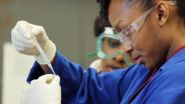(Press-News.org) COLUMBIA, Mo. – Shortly following the 9/11 terror attack in 2001, letters containing anthrax spores were mailed to news outlets and government buildings killing five people and infecting 17 others. According to a 2012 report, the bioterrorism event cost $3.2 million in cleanup and decontamination. At the time, no testing system was in place that officials could use to screen the letters. Currently, first responders have tests that can provide a screen for dangerous materials in about 24-48 hours. Now, researchers at the University of Missouri have worked with a private company to develop a new method for anthrax detection that can identify anthrax in only a few hours.
"Normally to identify whether an organism is present, you have to extract the material, culture it, and then pick colonies to examine that might turn out to be anthrax bacteria," said George Stewart, PhD, a medical bacteriologist at MU's Bond Life Sciences Center and chairman of the Department of Veterinary Pathobiology and McKee Endowed Professor within the MU College of Veterinary Medicine. "Then you conduct chemical testing which takes some time-a minimum of 24 to 48 hours. Using this newly-identified method, we can reduce that time to about five hours."
Using a virus known as a "bioluminescent reporter phage," Stewart and graduate student, Krista Spreng, tested the phage at the MU Laboratory for Infectious Disease Research. The phage, developed by David Schofield at Guild BioSciences, a biotech company in Charleston, S.C., is injected in the sample causing anthrax to glow if present. The team also found that the method can detect low levels of anthrax bacteria and rule out false positives. The added benefit to this reporting system is its ability to show if anthrax is present and whether or not the spores are alive, Stewart said.
The next step for the research team at MU and Guild BioSciences will be to get the bioluminescent reporter phage approved by federal regulatory agencies so a product can be produced and distributed, Stewart said.
"In the years since the post 9/11 postal attacks, we haven't had any bona fide anthrax attacks," Stewart said. "That doesn't mean that it's not going to happen, we just have to be prepared for when it does occur again."
The research, "Bacillus anthracis diagnostic detection and rapid antibiotic susceptibility determination using 'bioluminescent' reporter phage," was funded by the USDA and published in the Journal of Microbiological Methods.
INFORMATION:
Faster anthrax detection could speed bioterror response
Faster results could save millions in decontamination costs, MU study finds
2014-02-27
ELSE PRESS RELEASES FROM THIS DATE:
Montreal researchers find a link between pollutants and certain complications of obesity
2014-02-27
Montréal, February 27, 2014 – A team of researchers at the IRCM in Montréal led by Rémi Rabasa-Lhoret, in collaboration with Jérôme Ruzzin from the University of Bergen in Norway, found a link between a type of pollutants and certain metabolic complications of obesity. Their breakthrough, published online this week by the Journal of Clinical Endocrinology & Metabolism, could eventually help improve the prevention, diagnosis, and treatment of cardiometabolic risk associated with obesity, such as diabetes, hypertension and cardiovascular disease.
Although obesity is strongly ...
Battery-free technology brings gesture recognition to all devices
2014-02-27
Mute the song playing on your smartphone in your pocket by flicking your index finger in the air, or pause your "This American Life" podcast with a small wave of the hand. This kind of gesture control for electronics could soon become an alternative to touchscreens and sensing technologies that consume a lot of power and only work when users can see their smartphones and tablets.
University of Washington computer scientists have built a low-cost gesture recognition system that runs without batteries and lets users control their electronic devices hidden from sight with ...
Bisphenol A (BPA) at very low levels can adversely affect developing organs in primates
2014-02-27
COLUMBIA, Mo. – Bisphenol A (BPA) is a chemical that is used in a wide variety of consumer products, such as resins used to line metal food and beverage containers, thermal paper store receipts, and dental composites. BPA exhibits hormone-like properties, and exposure of fetuses, infants, children or adults to the chemical has been shown to cause numerous abnormalities, including cancer, as well as reproductive, immune and brain-behavior problems in rodents. Now, researchers at the University of Missouri have determined that daily exposure to very low concentrations of ...
Household wealth still down 14 percent since recession
2014-02-27
COLUMBUS, Ohio – Household wealth for Americans still has not recovered from the recession, despite last summer's optimistic report from the U.S. Federal Reserve, a new study suggests.
Economists at The Ohio State University found that the mean net worth of American households in mid-2013 was still about 14 percent below the pre-recession peak in 2006. Their analysis suggested that middle-aged people took the biggest hit.
In a report last June, the Federal Reserve said that net worth of Americans – which includes the value of homes, stocks and other assets minus debts ...
IUPUI study reveals how dogs detect explosives, offers new training recommendations
2014-02-27
INDIANAPOLIS— A research team at Indiana University-Purdue University Indianapolis (IUPUI) has helped determine the science behind how canines locate explosives such as Composition C-4 (a plastic explosive used by the U.S. military). The study found the dogs react best to the actual explosive, calling into question the use of products designed to mimic the odor of C-4 for training purposes. These findings are the culmination of a four-year contract funded by the U.S. Department of Defense (DOD).
"Appropriately, dogs that are trained to find real explosives are going ...
Type 1 diabetes: Vitamin D deficiency occurs in an early stage
2014-02-27
Vitamin D is known as a major regulator of calcium levels and bone metabolism. Furthermore, it also influences the immune system. Previous studies have shown that patients with recently diagnosed type 1 diabetes have significantly lower vitamin D levels.
Scientists from the Institute of Diabetes Research (IDF) and the Helmholtz Zentrum München, a member of the German Center for Diabetes Research (DZD), as well as from the Diabetes Research Group at the Technische Universität München (TUM) examined whether a vitamin D deficiency occurs during an early stage of type 1 diabetes, ...
Scientists learn how pathogens hack our immune systems to go undetected
2014-02-27
A new report appearing in the March 2014 issue of The FASEB Journal helps shed light on what drives the evolution of pathogens, as well as how our bodies adapt to ward them off. Specifically, the report shows that our bodies naturally employ a mechanism, called "CD33rSiglecs," that not only dampens unwanted immune responses against one's own cells, but also evolves rapidly to recognize foreign invaders. What's more, the report explains how pathogens exploit this immunological "vulnerability" of "self-recognition" to evade our bodies' defenses. This leads to a seemingly ...
Scientists highlight the importance of nutrients for coral reefs
2014-02-27
A new publication from researchers at the University of Southampton and the National Oceanography Centre, Southampton highlights the importance of nutrients for coral reef survival.
Despite the comparably small footprint they take on the ocean floor, tropical coral reefs are home to a substantial part of all marine life forms. Coral reefs also provide numerous benefits for human populations, providing food for millions and protecting coastal areas from erosion. Moreover, they are a treasure chest of potential pharmaceuticals and coral reef tourism provides recreation ...
Mentoring the next generation of black chemists (video)
2014-02-27
WASHINGTON, Feb. 27, 2014 — The American Chemical Society (ACS) is wrapping up its celebration of Black History Month with a focus on the future. A new ACS video showcases the mentors that are helping shape the next generation of chemists and chemical engineers. The video is available at http://youtu.be/6pX4kmHIeAE.
The video, produced with the National Organization for the Professional Advancement of Black Chemists and Chemical Engineers (NOBCChE), highlights the efforts of Isiah Warner, Ph.D., Boyd Professor at Louisiana State University, to mentor students in the ...
Researchers X-ray living cancer cells
2014-02-27
Göttingen-based scientists working at DESY's PETRA III research light source have carried out the first studies of living biological cells using high-energy X-rays. The new method shows clear differences in the internal cellular structure between living and dead, chemically fixed cells that are often analysed. "The new method for the first time enables us to investigate the internal structures of living cells in their natural environment using hard X-rays," emphasises the leader of the working group, Prof. Sarah Köster from the Institute for X-Ray Physics of the University ...
LAST 30 PRESS RELEASES:
Making lighter work of calculating fluid and heat flow
Normalizing blood sugar can halve heart attack risk
Lowering blood sugar cuts heart attack risk in people with prediabetes
Study links genetic variants to risk of blinding eye disease in premature infants
Non-opioid ‘pain sponge’ therapy halts cartilage degeneration and relieves chronic pain
AI can pick up cultural values by mimicking how kids learn
China’s ecological redlines offer fast track to 30 x 30 global conservation goal
Invisible indoor threats: emerging household contaminants and their growing risks to human health
Adding antibody treatment to chemo boosts outcomes for children with rare cancer
Germline pathogenic variants among women without a history of breast cancer
Tanning beds triple melanoma risk, potentially causing broad DNA damage
Unique bond identified as key to viral infection speed
Indoor tanning makes youthful skin much older on a genetic level
Mouse model sheds new light on the causes and potential solutions to human GI problems linked to muscular dystrophy
The Journal of Nuclear Medicine ahead-of-print tip sheet: December 12, 2025
Smarter tools for peering into the microscopic world
Applications open for funding to conduct research in the Kinsey Institute archives
Global measure underestimates the severity of food insecurity
Child survivors of critical illness are missing out on timely follow up care
Risk-based vs annual breast cancer screening / the WISDOM randomized clinical trial
University of Toronto launches Electric Vehicle Innovation Ontario to accelerate advanced EV technologies and build Canada’s innovation advantage
Early relapse predicts poor outcomes in aggressive blood cancer
American College of Lifestyle Medicine applauds two CMS models aligned with lifestyle medicine practice and reimbursement
Clinical trial finds cannabis use not a barrier to quitting nicotine vaping
Supplemental nutrition assistance program policies and food insecurity
Switching immune cells to “night mode” could limit damage after a heart attack, study suggests
URI-based Global RIghts Project report spotlights continued troubling trends in worldwide inhumane treatment
Neutrophils are less aggressive at night, explaining why nighttime heart attacks cause less damage than daytime events
Menopausal hormone therapy may not pose breast cancer risk for women with BRCA mutations
Mobile health tool may improve quality of life for adolescent and young adult breast cancer survivors
[Press-News.org] Faster anthrax detection could speed bioterror responseFaster results could save millions in decontamination costs, MU study finds






